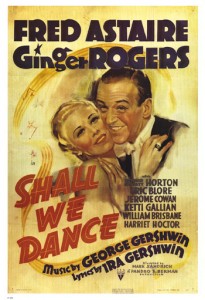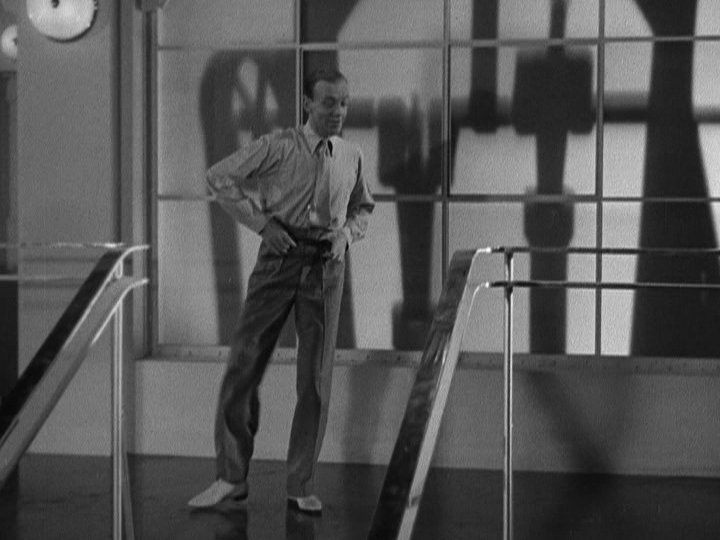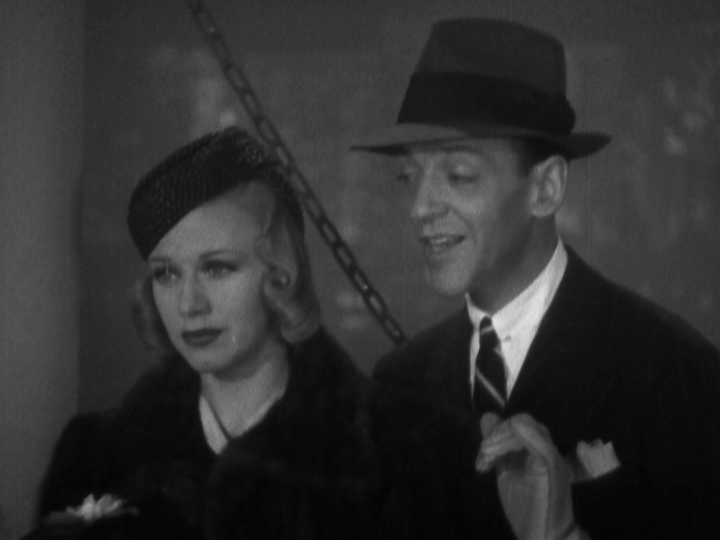“We’re about the only two people in the world who don’t think we’re married.”
|

Synopsis:
A ballet dancer (Fred Astaire) smitten with a popular musical comedy star (Ginger Rogers) pursues her onboard an ocean liner, where the pair are mistakenly identified as married.
|
|
Genres, Themes, Actors, and Directors:
- Dancers
- Fred Astaire Films
- Ginger Rogers Films
- Mistaken or Hidden Identities
- Musicals
Response to Peary’s Review:
Peary accurately notes that this seventh on-screen pairing of Fred Astaire and Ginger Rogers — featuring a “silly plot” about dancers “mistaken for marrieds” — is “not great, but… enjoyable”. Edward Everett Horton’s performance (as Astaire’s manager) almost satirically epitomizes the type of flustered character he became known for in the series, while Eric Blore has fun in a bit role as a moralistic hotel manager valiantly attempting to determine whether Astaire and Rogers really are married or not. The film’s highlights, naturally, are when Astaire and Rogers dance and/or sing “to the songs of George and Ira Gershwin”, including “‘They All Laughed’, ‘They Can’t Take That Away From Me’…, ‘Let’s Call the Whole Thing Off’ — during which Astaire and Rogers are on roller skates — and ‘Shall We Dance’.” Indeed, the score itself almost makes it must-see from a cultural perspective (though I suppose one could simply watch clips of each song or dance separately on YouTube). While it’s hard to choose, I’d say my all-time favorite of the bunch is Astaire’s solo dance to “Slap That Bass”, taking place in a boiler room; watching just a few seconds of rehearsal footage from this number made me appreciate all over again exactly how much of a joyfully limber-footed genius Astaire really was.
Redeeming Qualities and Moments:
- Creative opening titles

- Astaire’s solo dance to “Slap That Bass”

- Astaire and Rogers’ dance to (and duet of) “Let’s Call the Whole Thing Off”

- Astaire crooning “They Can’t Take That Away From Me” to Rogers

- Typically fine Art Deco sets by Van Nest Polglase

- George and Ira Gershwin’s incomparable score
Must See?
No, though it’s definitely worth a look just for the songs and dances (naturally).
Links:
|
One thought on “Shall We Dance (1937)”
A must – but only for the film’s score (which is too good to miss) & the way Fred and Ginger sell the songs.
On the DVD, there is a wonderful extra – ‘The Music of ‘Shall We Dance’ – which gives a brief history of how the film came to be and how each song was incorporated. Though short, it’s an incisive look at musical filmmaking of the period. (~reaching a sad note when we’re reminded that George Gershwin died soon after completing the film – a brain tumor at age 38.)
It’s strange to sense that one could almost view this film with remote in hand and simply skip to the songs, thereby using them as the means to understand the plot. That’s what I more or less recommend to the viewer, at any rate. As I’ve noted elsewhere, once F&G became an established and successful team, the scripts of their projects took a nosedive in quality – most often leaving audiences to endure low-level comedy, almost bereft of wit. ‘SWD’ has a very thin plot indeed, and there’s way too much of it as it plays out. (We seem to wait forever for the first number – the incredible ‘Slap That Bass’.) Whoever put this package together must have thought, ‘Well, the songs are the centerpiece.’ And, indeed, they are – this may arguably be the F&G film with the best score! – but that’s no excuse for a lackluster script. (Sections of this are actually embarrassing.)
Still, the George & Ira Gershwin tunes are so good and so well done that ffs owe it to themselves to take them in at least once. Overall, the film is strikingly mounted, which may ease the pain of the dialogue some. It’s just unfortunate that no one had the idea of respecting the score enough to augment it with a worthy storyline and much better jokes.